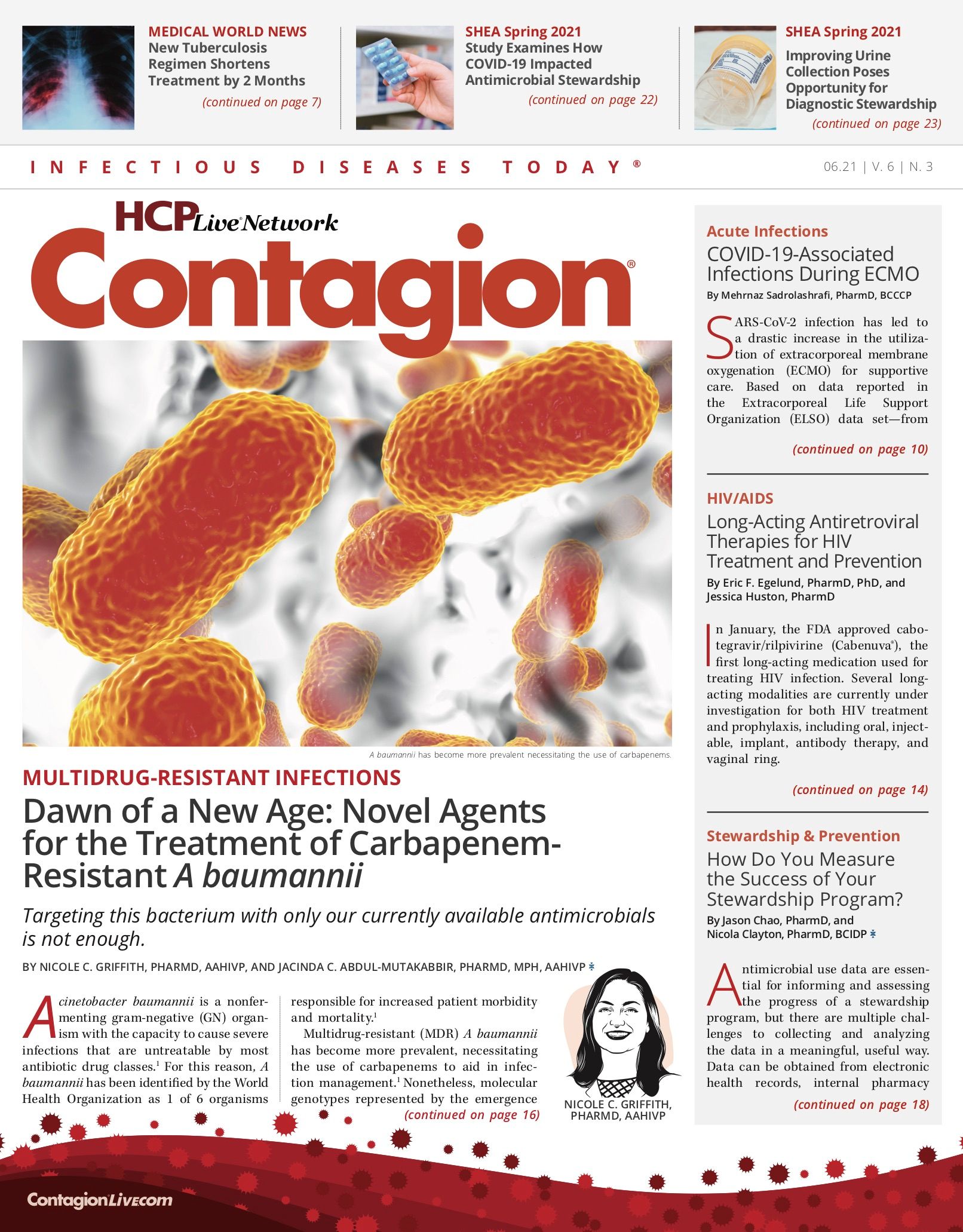Panel
Moderator
Peter L. Salgo, MD
Columbia University Irving Medical Center
New York, NY
Panelists
Teena Chopra, MD, MPH
School of Medicine—Wayne State University
Detroit, MI
Paul Feuerstadt, MD
Yale New Haven Hospital
New Haven, CT
Dale N. Gerding, MD
Edward Hines Jr Veterans Affairs Hospital
Chicago, IL
Thomas Lodise, PharmD, PhD
Albany College of Pharmacy and Health Sciences
Albany, NY
Joseph Reilly, PharmD
AtlantiCare Regional Medical Center
Atlantic City, NJ
Identification of patients to undergo testing for Clostridiodes difficile infection (CDI) is largely based on a high index of suspicion, although the role of asymptomatic carriage in transmission highlights the importance of infection control in inpatient and outpatient settings, according to experts who participated in a Contagion® Peer Exchange panel. The discussion, moderated by Peter L. Salgo, MD, also discussed recommendations for treatment of recurrent CDI and considerations for selecting the most appropriate treatment method.
C difficile: A Differential Diagnosis
The 2017 guidelines from the Infectious Diseases Society of America (IDSA) and Society for Healthcare Epidemiology of America (SHEA) state that patients with unexplained and recent onset of at least 3 unformed stools in a 24-hour period are the “preferred target population for testing” of CDI.1 However, Teena Chopra, MD, MPH, noted that presentation of CDI can range from mild symptoms to severe sepsis, fulminating colitis, or death and that clinical judgment is the most important consideration when selecting patients for testing. She said that presence of risk factors for CDI along with fever, elevated white blood cell (WBC) count, and frequent diarrheal stools increases suspicion; however, she added that diarrhea can also be associated with antibiotics, parasites, or consumption of contaminated food or water and that testing every patient with diarrhea would likely lead to overdiagnosis because individuals may be colonized with nontoxigenic forms of C difficile.
Joseph Reilly, PharmD, noted that with the increase in pay-for-performance initiatives and public reporting of CDI rates, hospitals are particularly motivated to ensure that the CDI rates are low to prevent financial penalties and that positive tests for patients who are colonized with nontoxigenic C difficile would artificially inflate the rates. Paul Feuerstadt, MD, added that, rather than testing for CDI in any patient with diarrhea as a “knee-jerk reaction,” clinicians should broaden the differential diagnosis and evaluate the clinical presentation, such as assessing for the presence of blood in the diarrhea or whether the diarrhea is secretory or osmotic.
He added that irritable bowel syndrome (IBS) and postinfection IBS can complicate the clinical picture and that it is important to determine whether another bout of diarrhea indicates a recurrent infection or an alternative issue in a patient with a history of CDI to direct therapy appropriately. However, Feuerstadt said that patients with inflammatory bowel disease (IBD) are an exception, so all patients with IBD who experience an exacerbation should undergo testing for CDI because of the high incidence in this population.
Testing for CDI
Feuerstadt said that in addition to the IDSA/SHEA guidelines that provide recommendations for selecting candidates for testing, factors such as WBC count, creatinine level, and recent history of antimicrobials are also helpful to consider.
“If a patient has loose stools and recently received antimicrobials, they’re in the [intensive care unit], and their white [blood cell] count is 40,000, you probably know what’s going on there,” he said. “That might be a circumstance where time is of the essence and you might send off a stool assay before starting antimicrobials, but you may also want to empirically start antimicrobials due to your suspicion that [C difficile infection] is present.”
Dale N. Gerding, MD, also pointed out that the work-up for a patient with community-acquired diarrhea needs to be different than for a patient with health care–associated diarrhea, in which CDI is high on the list of probable causes. For example, he recommended a multiplex polymerase chain reaction platform for patients with community-associated diarrhea to rule out multiple other potential causes.
In general, tests for CDI detect the organism itself or its primary toxins (toxin A and/or B). Commonly available options include toxigenic culture, nucleic acid amplification test (NAAT), glutamate dehydrogenase (GDH) assay, cell culture cytotoxicity neutralization assay, and toxin A and B enzyme immunoassays. Gerding noted, however, that the cell culture cytotoxicity neutralization assay has become obsolete because it is time consuming and difficult to perform.1
The NAAT is among the more commonly used tests in the United States and detects several toxin gene targets in the organism, although it has a low to moderate specificity and may pick up cases of patients colonized with C difficile, according to Gerding. He added that specific toxin tests, typically performed using enzyme immunoassays for toxin A and/or B, identify toxigenic C difficile strains but have low sensitivity and that GDH assays are commonly used but need paired with another diagnostic test because GDH is found in toxigenic and nontoxigenic strains.
The IDSA/SHEA guidelines recommend using a stool toxin test as part of a multistep algorithm for diagnosis, which may involve GDH plus toxin test, GDH plus toxin test followed by NAAT as an arbitration test, or NAAT plus toxin test.1 However, Gerding noted that the difference in diagnostic yield among the algorithms may be introducing inconsistencies with diagnosis of CDI in current practice.
Screening for C difficile
According to Chopra, asymptomatic carriage is an important consideration because carriers can act as reservoirs of transmission and probable vehicles of transmission to other patients. She added that the rate of asymptomatic carriage varies, with rates as high as 50% among older adults and approximately 5% to 10% among healthy adults.
“It’s important that we understand and realize that...these asymptomatic carriers don’t have diarrhea, but we are detecting [Clostridioides] difficile and they can transmit it,” she said, emphasizing the importance of infection control with hand hygiene and contact precautions in outpatient care settings and dialysis units and in inpatient care settings.
However, Chopra added that testing asymptomatic patients for carriage in the hospital setting is not routinely performed and would be a poor use of resources, and even hospitalized patients with risk factors for asymptomatic carriage are only put in contact isolation to prevent transmission if the hospital is facing an outbreak. Gerding noted that the data are currently insufficient to recommend universal screening for CDI, in part, because testing is invasive and isolation of positive patients would use a large number of isolation rooms. “I think we need more data before we jump on the colonization bandwagon, even in hospitals,” he said.
C difficile: Clinical Practice Guidelines and Treatment Options
According to the 2018 IDSA/SHEA guidelines, the recommendations for management of the first recurrence of CDI are a prolonged tapered and pulsed vancomycin regimen or fidaxomicin (if a standard vancomycin regimen was used previously) or a standard vancomycin regimen (if metronidazole was used for the previous infection).1 However, Thomas Lodise, PharmD, PhD, noted that metronidazole has largely fallen out of favor for CDI infection because it has a broad spectrum of coverage (likely eliminating gut bacteria that are protective against CDI) and has been shown to have lower rates of efficacy than vancomycin. The inferior response rate of metronidazole to vancomycin was demonstrated in a pooled analysis of 2 multinational trials designed to compare clinical success of tolevamer, a nonantibiotic toxin-binding polymer, with vancomycin and metronidazole, respectively, in patients with CDI.2 Tolevamer was found to be inferior to both antibiotics, and rates of clinical success were higher with vancomycin than with metronidazole (81.1% vs 72.7%).2
“That’s what built up this concept on the clinical side [that] metronidazole is less targeted and alters the gut microbiota, which leads to higher risk for recurrence,” Feuerstadt said.
For second or subsequent recurrences, regimens recommended by the 2018 IDSA/SHEA guidelines include tapered and pulsed regimen of vancomycin, standard vancomycin regimen followed by rifaximin, fidaxomicin (if not used for prior infections), and microbiota replacement therapy or fecal microbiota transplantation (although the expert panel recommended appropriate antibiotic regimens for at least 3 episodes of CDI prior to trying this strategy).1
Feuerstadt noted that these recommendations in the 2018 guidelines have changed substantially from 2010, as metronidazole was largely removed from 2018 guidelines in favor of vancomycin or fidaxomicin in the first-line setting and fidaxomicin was introduced as an option for treatment of first recurrence.
Reilly concluded that assessing likelihood of patient compliance with the regimens, particularly the 8-week pulsed tapered vancomycin regimen, is important when selecting a treatment plan. He said in his experience, compliance tends to drop off after getting past the twice-per-day portion of the regimen. Salgo added that compliance is particularly difficult when dosing frequency drops to once every 2 to 3 days.
“We have to think about the patients we see who have [C difficile infection],” Reilly said. “Are they going to be compliant with this, taking vancomycin 4 times per day for possibly 2 weeks, then another 2 times per day for a week, once per day for another week, and every 2 to 3 days for up to 8 weeks? That’s a demanding regimen that we have to put a patient on. I understand the efficacy behind it, but we shouldn’t approach it and say, ‘Oh, I’ll just use that’ when there’s an alternative available that might be easier [and] that the patient might be more compliant with.”
References
- McDonald LC, Gerding DN, Johnson S, et al. Clinical practice guidelines for Clostridium difficile infection in adults and children: 2017 update by the Infectious Diseases Society of America (IDSA) and Society for Healthcare Epidemiology of America (SHEA). Clin Infect Dis. 2018;66(7):e1-e48. doi:10.1093/cid/cix1085
- Johnson S, Louie TJ, Gerding DN, et al; Polymer Alternative for CDI Treatment (PACT) investigators. Vancomycin, metronidazole, or tolevamer for Clostridium difficile infection: results from two multinational, randomized, controlled trials. Clin Infect Dis. 2014;59(3):345-354. doi:10.1093/cid/ciu313


